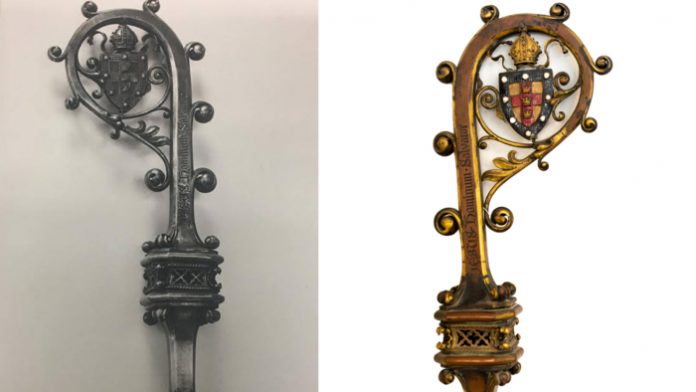The mystery of the missing crozier is solved – its location at least, if not its reason for going missing.
The Diocese of Pennsylvania’s century-old bishop’s staff was crafted by renowned blacksmith Samuel Yellin, a European immigrant who arrived in Philadelphia in 1906 and died in 1940. Its existence, however, has long been little more than local legend, and Pennsylvania Bishop Daniel Gutiérrez had been on the hunt for the missing crozier nearly since his consecration in 2016.
Then two weeks ago, Gutiérrez got a call from the Rev. Michael Ruk, rector at St. Philip’s Episcopal Church in New Hope, alerting the bishop that a parishioner had spotted what looked like the historic crozier on an online auction site. The auction’s description of the item included no mention of Yellin but said the staff had been given to Pennsylvania Bishop Philip Rhinelander in 1921. “There is some damage at the top including a dent and cracks,” the description said.
Gutiérrez decided to bid $125 for it, figuring it was an artifact worth preserving even if it wasn’t the long-lost Yellin crozier. When the auction closed on Jan. 19, Gutiérrez had the winning bid of $850, which came to about $1,100 with fees. The following Monday, he and his wife drove north from Philadelphia to the auction house in Lansdale to pick it up. When Gutiérrez saw the crozier in person, his hopes rose immediately.
“I said, ‘That’s it.’ You get this feeling,” Gutiérrez told Episcopal News Service in an interview this week. He sent a picture of the crozier to Yellin’s granddaughter, Clare Yellin, who has been helping the diocese with its research. She agreed with Gutiérrez that the staff appeared to be the missing Yellin crozier.
Bishops’ use of croziers dates to the seventh century, according to “An Episcopal Dictionary of the Church.” Originally designed as a walking stick, today it represents pastoral authority, its shape symbolizing a shepherd’s crook. By church custom, the bishop holds the crozier in the left hand with the crook facing outward.
Upon consecration, each bishop typically receives a new crozier for official use during pastoral visits around the diocese – Gutiérrez’s own crozier is a simple staff made of wood – but the value of a historic crozier like the copper one crafted by Yellin is more than ceremonial. “A historic crozier has the life of the diocese [in it] and tells the story of the diocese and the bishops that carried it,” Gutiérrez said.
While the origins of the Yellin crozier were known, “we’ve had no idea where it’s been since 1961,” Gutiérrez said. That was the last year in which references to the crozier could be found in the diocese’s archives.
So, while the crozier’s discovery solves the mystery of its location, it remains unclear how it got in the hands of the auction house or even who sold the staff to Gutiérrez. The auction house declined to provide information about the seller, he said.
The only hint of the crozier’s recent provenance was found on a piece of paper stuck in one of the staff’s ornamental florets. It suggests the crozier was sold previously at a flea market in Allentown in 2006.
Gutiérrez, who has a bachelor’s degree in history, initially purchased the crozier with money from his discretionary fund but later decided to reimburse the fund personally, offering the crozier as a gift back to the diocese. Pennsylvania was one of the founding dioceses of The Episcopal Church in 1785, and its first bishop, William White, became the first presiding bishop of the church in 1789. “We have to remember our past, especially here,” Gutiérrez said.
He plans to continue using his wooden crozier when he visits congregations around the diocese but will bring out the restored Yellin crozier on special occasions, possibly beginning in April when he celebrates the Easter Vigil in the diocese.
“I can’t wait to get it back to see what it looked like in its original state,” Gutiérrez said. “The only thing I’m concerned about is how are we going to make sure that it doesn’t go missing again.”



